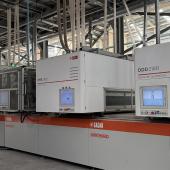Mohawk Industries’ global ceramic segment weathers the storm
The group’s Global Ceramic BU closed the year 2023 with net sales at $4.3 billion, down 0.17% on 2022 following the previous year’s 10% growth.

Mohawk Industries began to see signs of a slowdown in 2022, when net sales grew by just 4.8% compared to the 17.3% increase of 2021. In 2023, the group was unable to avoid a contraction, a result that was entirely foreseeable given the severe decline in demand that affected almost all global markets last year. For the flooring giant and global leader in the ceramic tile sector, this marked the second contraction since 2011 (the first was in 2020, the year of the pandemic), while the only other downswing in the last 30 years occurred during the subprime mortgage crisis between 2007 and 2010.
Commenting on the 2023 full year results, Mohawk Industries Chairman and CEO Jeff Lorberbaum noted that the decline in revenue was less significant than anticipated due to a better-than-expected fourth quarter (down 1.4% on the same period in 2022) and the positive effects of cost containment, increased productivity and the gradual decline in energy and raw material costs.
For the twelve months of 2023, net sales totalled $11.1 billion, a decrease of 5.1% from $11.7 billion in 2022 and slightly below 2021 levels. Adjusted net earnings also declined to $587 million from $823 million in the previous year.
Global Ceramic segment maintains 2022 levels
The Global Ceramic segment regained momentum in the fourth quarter, reporting a 0.6% increase in net sales compared to the same quarter in 2022, thus helping to mitigate the losses of 2023. The year’s net sales remained almost unchanged at $4.3 billion (down 0.17% on 2022 following the previous year’s 10% growth) and accounted for 39% of Mohawk Industries’ consolidated net sales. The segment’s operating margin was 4.2% (adjusted operating margin 7%).
Various measures were implemented to contain costs, including increasing productivity, reducing overheads and implementing alternative formulations. Production was managed to align with demand, while inventory was significantly reduced throughout the year.
2023 was also the year of the integration of Vitromex in Mexico and Elizabeth in Brazil. In both countries, demand significantly declined last year due to rising interest rates and slowing economic conditions, which reduced the group’s results despite efforts to enhance sales, marketing and operational strategies.
In the US, Lorberbaum noted that the group is expanding its distribution through local service centres and offering new collections with premium Italian styling to improve its product mix. In Italy, the group is optimising its recent expansion of premium porcelain slabs to meet growing demand in both the residential and commercial channels.
The contraction in the group’s other two segments was more pronounced. In 2023, the Flooring North America segment’s sales declined by 9% over 2022, to $3.8 billion; the Flooring Rest of the World segment also declined by 6.7% to $3 billion.
Greater confidence for 2024
Lorberbaum believes that the industry is at a cyclical low and from this point on is bound to improve.
“We expect seasonality in the first quarter to be more aligned with long-term historical levels,” he said.
The group’s results should improve in the second half of the year due to more favourable market conditions and the results of actions initiated during the past eighteen months to improve the cost structure and integrate recent acquisitions.
Markets anticipate that central banks will lower interest rates, expanding home sales, residential remodeling and commercial projects.
“The pace of improvement of the flooring category will be dependent on inflation rates, consumer confidence and the strength of home sales,” commented Lorberbaum. “We believe the US and Latin American markets could improve before Europe, which could lag due to current geopolitical pressures. After past housing recessions, our industry has rebounded with increased sales and expanding margins for multiple years. Housing remains in short supply across all our geographies, and increased remodelling investments will be required to update the aging housing stock.”

Did you find this article useful?
Join the CWW community to receive the most important news from the global ceramic industry every two weeks






















